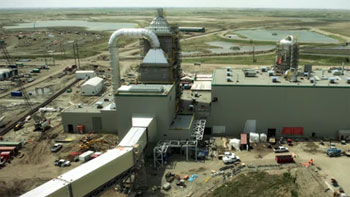The world’s first big carbon capture experiment has begun at a Saskatchewan coal-fired power plant, which will purportedly sequester almost all of its emissions.
This first commercial-scale project will capture about a million tons of carbon a year in the World’s First Post-Combustion Coal-Fired CCS project.
Canadian utility SaskPower plans to capture 90% of emissions at the 110 megawatt Boundary Dam power station. If this $1.35 billion experiment works, they plan to retrofit the other two units at a cost of 20-30% less. Building the technology for the first unit has already revealed ways to make improvements on design and engineering, they say.
Boundary Dam is important because the technology is added to a typical 40-year-old coal plant. Most of the carbon it captures will be sold for enhanced oil recovery – recouping project costs – similar to the $1 billion project NRG is developing in Texas. The rest will be stored deep underground in rock formations.

Critics say it’s doubtful that carbon capture will be widely used, however, because if SaskPower is successful, it’s because of its unique location. It sits on a 300-year supply of inexpensive coal and there are enough oil fields nearby to use and store the carbon long-term. And it’s getting government subsidies.
SaskPower counters that there are other byproducts they plan to sell, such as fly ash and sulphuric acid, but until project costs come down they agree that having revenue stream is critical for carbon capture to make economic sense.
In any event, the utility is being pushed in this direction because of power plant regulations in Canada, the very same ones that EPA now proposes for the US.
Another criticism is that coal plants are on their way out because the world will be flush with cleaner natural gas.
"There are 7,000 coal-fired turbines on the planet right now and they are not going to be turned off any time soon because people need the energy they produce," Ian Yeates of SaskPower told The Guardian. "Is there going to be enough gas to replace all those units? We are going to be burning fossil fuels as a world economy for many many decades if not a century or two as energy demands grow…something like carbon capture and sequestration will be of value to deal with that."
Other smaller carbon capture projects are in Illinois (from an ethanol plant), Texas and in Norway (from a refinery). Most other projects in the US and EU have been cancelled.
The Department of Energy has made $8 billion available for advanced fossil fuel technology development, such as Advanced Technology Materials Inc’s low-cost process and Heat Mining Company’s combination with geothermal.
